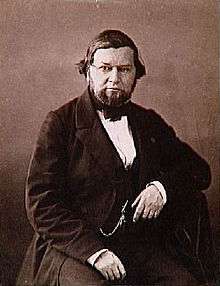Eugène-Melchior Péligot

Eugène-Melchior Péligot (24 March 1811 in Paris – 15 April 1890 in Paris), also known as Eugène Péligot, was a French chemist who isolated the first sample of uranium metal in 1841.[1]
Péligot proved that the black powder of Martin Heinrich Klaproth was not a pure metal (it was an oxide of uranium, known in chemistry as UO2). He then succeeded in producing pure uranium metal by reducing uranium tetrachloride (UCl4) with potassium metal.[2] Today better methods have been found.[3]
Péligot's salt is also named after him.
Péligot was a professor of analytical chemistry at the Institut National Agronomique. He collaborated with Jean-Baptiste Dumas, and together they discovered the methyl radical during experiments on wood spirit (methanol). The terminology "methyl alcohol" was created by both chemists from "wood wine". They also prepared the gaseous dimethyl ether, and many esters. In 1838, they successfully transformed camphor into p-cymene using phosphorus pentoxide.
In 1844 he synthesized chromium(II) acetate,[4][5] which was much later recognized (by F. Albert Cotton in 1964) to be the first chemical compound which contains a quadruple bond.[6]
See also
References
- ↑ http://www.epa.gov/radiation/radionuclides/uranium.html
- ↑ Celestial Bodies
- ↑ Uranium - LoveToKnow 1911
- ↑ Peligot, E.-M. (1844). "Sur un nouvel oxide de chrome". C. R. Acad. Sci. (in French). 19: 609-618.
- ↑ Peligot, E.-M. (1844). Ann. Chim. Phys. (in French). 12: 528. Missing or empty
|title=(help) - ↑ Cotton, F. A.; Walton, R. A. "Multiple Bonds Between Metal Atoms" Oxford (Oxford): 1993. ISBN 0-19-855649-7.